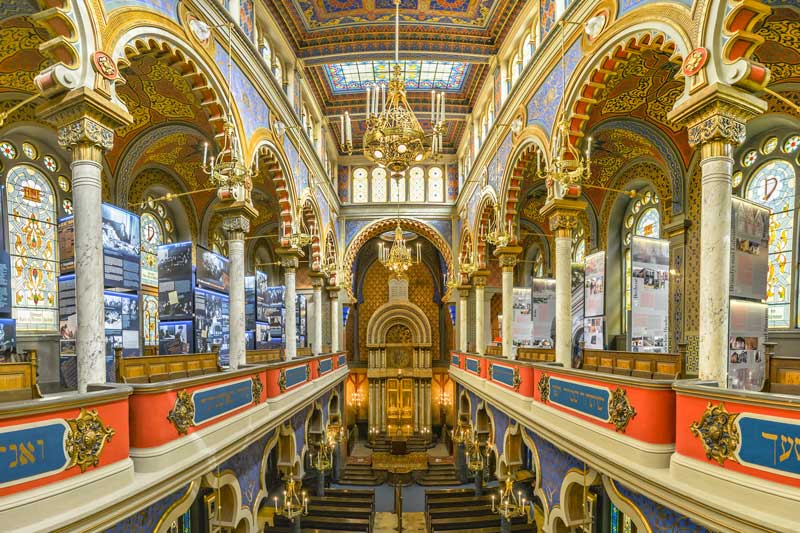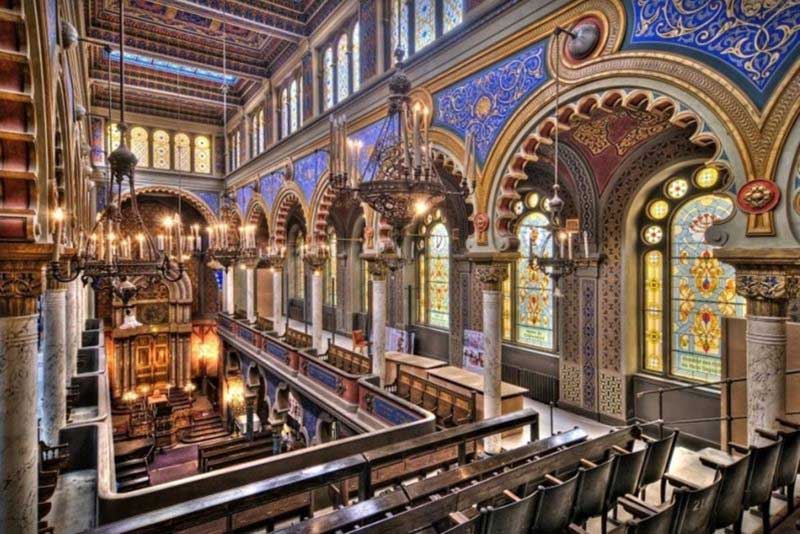
Located on Jerusalem Street in Prague, the Capital and the largest city of the Czech Republic and built between 1905 and 1906 designed by a Viennese architect Wilhelm Stiassny, the Jubilee Synagogue has been a religious and cultural centre for the Jewish community of Prague since 1906.
Built as a replacement for three Synagogues destroyed during the redevelopment and reflecting a unique confluence of the Art Nouveau and Moorish architectural styles, it was initially named the Jubilee Temple of Emperor Franz Joseph to commemorate the 50th anniversary of his reign in the defeated Austro-Hungarian Monarchy in 1898. However, after the independence of Czechoslovakia in 1918, it was renamed the Jerusalem Synagogue, after the name of the street where it stands, although the street was named after the Church of Jerusalem, the former chapel of St Henry, which stands nearby.

The site of the Jubilee Synagogue was once part of the legendary ghetto of Prague, the former Jewish quarter. Initially, it was the smallest district of old Prague, a dirty island of residential space, covering an area of around 86000 square feet, which was gradually invaded by the poor, the marginalized and the prostitutes. Soon, the brothels with their red lanterns and the shady taverns multiplied among the private dwellings and the places of worship. The synagogues, with their mysterious and otherworldly facades, stood out among the sordid hovels and the prayers and sacred songs of the Jews mingled with the blaring music of the gambling houses.
However, the scenario started to change swiftly with the beginning of the renovation of the city centre in 1897 and the Jubilee Synagogue started to come up replacing the Zigeiner and the Velkodvorská, while the Old New Synagogue, also known as the Altneuschul, was demolished and replaced by the Spanish Synagogue.

The unique red-and-white coursing of the stone façade of the Jubilee Synagogue, an early twentieth century religious and cultural building, is decorated with horseshoe arches, while its large central arch frames a rosette window with the Star of David. Apart from the façade, two rows of horseshoe arches also support the women’s gallery, adding a unique architectural movement to the synagogue. A deep triple nave of the Synagogue is illuminated by stained glass windows. However, in the inside, the Moorish elements are overlaid with brilliantly painted Art Nouveau patterning.
It is interesting to note that the Jubilee synagogue preserves the inscribed plaques removed from the former Zigeiner Synagogue, which was demolished by the urban renewal campaign to make room for the construction of the Jubilee synagogue. Besides that, it also uniquely preserves an organ, which was once played by Emanuel Stephen Peter.

The Jubilee Synagogue is the only one of the eight Synagogues, designed by Wilhelm Stiassny, where services are still held, since the day when it opened its doors as a house of worship. However, services were suspended during the period when the city was under Nazi German occupation during the Second World War and the space was used by the Nazis as a warehouse to dump the confiscated Jewish property.


Shortly after 1989, when the Jewish community of Prague and its institutions were once again established, restoration of the stained-glass windows of the Synagogue began in 1992 and apart from restoration work on the façade and portal, the upper floor prayer hall was also renovated within five years. After brightening the interior vaults and cleaning the polychrome surfaces, the team for conservation and restoration removed sediments, dirt and impurities from paint layers, damaged by humidity. Finally, after a century of its inception as a house of worship, the Jubilee Synagogue opened its doors to the visitors on a regular basis on 1 April 2008. Apart from its original function as a place of worship, it also serves as a centre of cultural activities for the community in Prague, where exhibitions and concerts are regularly held